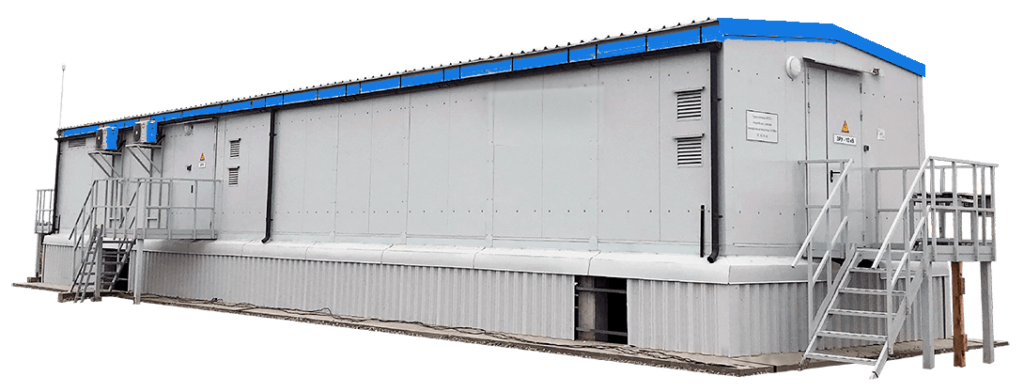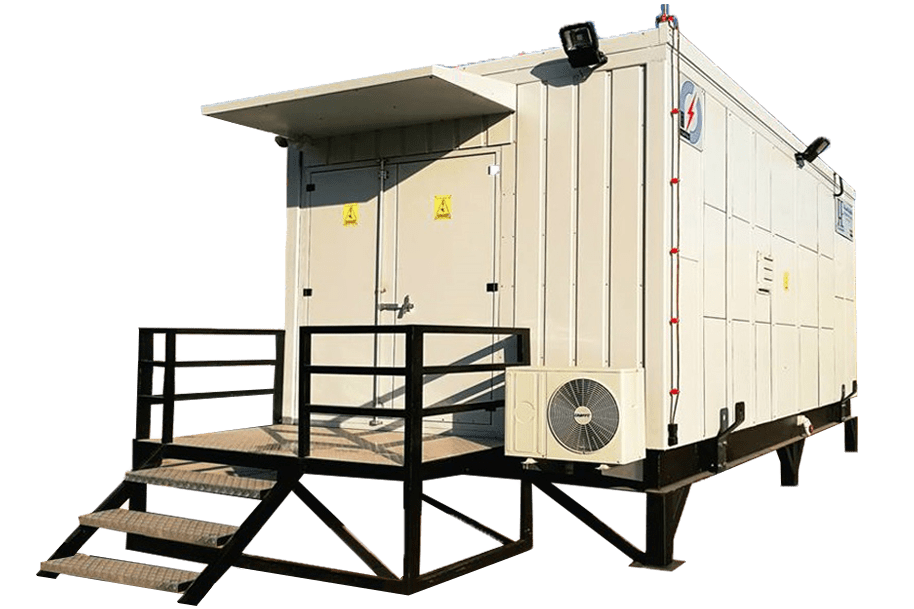E-House (Electrical House)
What is an E-House?
Electrical House (E-House) is a prefabricated walk-in modular enclosure to house medium and low voltage switchgear as well as auxiliary equipment.
The intent of the E-House is to provide medium and low-voltage equipment along with an outdoor enclosure, skid or wheel-mounted ready to operate in the field with minimum installation, commissioning, and start up time. An alternative to traditional on-site building construction (concrete block, brick construction, or similar)

A new age solution to power distribution
Why an E-House?
What problem our E-House will solve?
Cost Effectiveness
- Reduce site cost
- Reduce procurement cost
- Reduce management resources
- Cost-effective relocation
- Reduce management resources
- Cost-effective relocation
- Reduced building time
- Little infrastructure required at the site
- Reduction of the storage area
Flexibility
- Product integration
- Modular design
- Optimal building size
- Deploy time
- Space constraint
- Flexibility of voltage
- Robust equipment
- Unique engineering for the integration
Convenience
- Single contract to supply a full solution
- Product integration
- Deploy time
- One point contact
- Reduce on-site risks
- Maintenance contracts
- Warranty
- Shorter assembly time in field
- Pre-commissioning
One-Stop-Shop
Why an E-House from us?
Professional engineering, custom designs, and standard product offerings driven by experience and backed by supportive, knowledgeable project management and comprehensive field service mean, WE are your one-stop-shop for Complete E-House solutions.
Cost Effectiveness
- 9COM Facility;
- Pre-Post sales consultancy;
- 24/7 after-sales service;
- Yearly maintenance contracts;
- Local presence (delivery, FAT, SAT, etc. advantages);
- 100% Saudi owned company (IKTIVA);
- Own established approved workshop (controlled indoor facility);
- Provide complete operating training (one time);
- Availability of critical spare parts;
- Approved 3rd party suppliers;
- Made-In-Saudi accreditation (logo mark);
- Strategic partnership with OEMs like Schneider Electric & Siemens for the complete portfolio of medium and low voltage switchgears;
- Deep Technical analysis of the request by the E-House design team;From design to a delivery – single point of contact for all equipment;
Main components of an E-House
- Main Distribution Boards;
- Low, medium, and high voltage switchgear;
- Low and medium voltage transformers;
- Low and medium voltage motor control centers;
- Low and medium voltage Variable Frequency drives;
- UPS & Batteries;
- AccuSine (stabilizes electrical networks by providing harmonic mitigation, power factor correction, and load balancing);
- Distribution Panels & associated electrical equipment;
- Lighting & Electrical system;
- Safety System;
- Fire Protection System;
- HVAC System;Others (if required)

Introducing SMART E-House

SCADA (Supervisory Control & Data Acquisition)
User-oriented graphic environment with full graphic resources and real time working tools;
Support for making full use of IED functions through flawless communication;
Storage of long-term data using the relational database;
Report generation with various formats reflecting user req.

SAS (Substation Automation System)
Makes possible communication with various Intelligent Electronic Devices (IEDs);
Increases the convenience of operation through the remote setting function of the IEDs;
Support for large capacity data communication in real time by applying the OS and TCP / IP Protocol.

DMS (Distribution Management System)
Supports auto-tracing the point of accident;
Automatic decision function in breakdown mode (manual / automatic);
Automatic separation and recovery support in the failed area;
Supports various wired and wireless communication (RF, CDMA, optical.

EMS (Energy Management System)
Uses real time OS to process real time data;
Web monitoring function support (option);
A program which simulates the effect of separating the power line and generator in cases of accident.
We provide Complete Engineering Analysis
Structural Analysis
Interpretation of structural deformation from external loads (air pressure, snow, wind, total weight with equipment)
Thermal Analysis
Thermal deformation and thermal stress analysis of objects during temperature change.
Analysis of Flow
Analysis of characteristic values such as velocity, temperature and pressure of liquid and gas.
Seismic Analysis
As a method to understand the dynamic characteristics of the structure, a mounted module shape is tested to predict whether the structure is resonant or deformed by vibration.
Lighting Calculation Report
Optimized illumination design by calculating illumination volume.
Foundation Loading Data
Analysis of the foundation loading data considering the center of gravity of the container.
